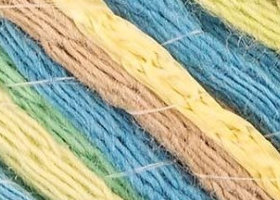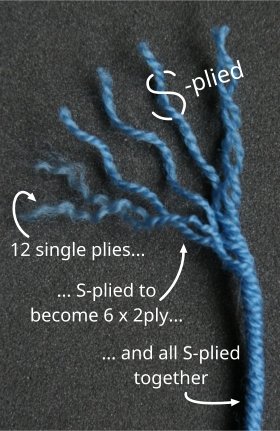Note: In this article, the number of plies refers to the number of strands of fiber within the yarn. Confusingly, a ply number is used as a yarn weight in some countries, e.g. a fingering weight yarn is often called "4-ply" in the UK and Australia, regardless of how many strands the yarn actually has.
Single ply
As the name suggests, this is just one strand of fiber. With a single ply yarn, manufacturers walk a tightrope between too much twist - leading to an 'unbalanced' yarn that might leave you with a biased piece of knitting - and too little twist, giving a yarn that breaks and pills easily.
The rounded cross-section of a single ply yarn allows individual stitches to fill all the space available to them, giving a cohesive look and a cosy feel to the fabric. The stitches are smooth and bright, without the shadows that come from multiple plies.
Singles are not well-suited to items which will get a lot of wear and tear, like socks or gloves for example.
Two-ply
Two-ply yarns have a definite wavy edge, as the two strands wind around each other with nothing else to fill out the gaps. They are stronger than single ply yarns, with the fibers more supported and protected from breaking by the extra twist. They are also more balanced and unlikely to produce a biased fabric, with the excess twist from the individual plies being used to twist each around the other.
The wavy edge means they can be good for color-work, blending the borders of color changes. They are also traditionally used for lace knitting.
Three-ply
Three-ply yarns are more durable than single or two-ply yarns, with all of the twist in the individual plies plus the extra twist to ply them together. They are more round in cross-section than two-ply yarns, less round than single ply yarns, but stronger.
Four-ply plus
The more plies in a yarn, the stronger, more durable and more rounded it becomes, giving good structure to textured stitches and cables. The more plies you add, the more dense the yarn becomes, as all available space within the column of yarn is used up.
Cabled yarns

Plied yarns can themselves be plied together. This is a great construction for a wool fiber like Merino, with the relatively short, soft but delicate fibers being protected by the high total twist in the yarn. These yarns are perfect for textured stitch patterns like seed stitch (UK = moss stitch) and cables. They are strong, and resistant to pilling. But all those plies also keep the fiber very much under control, so it's not a yarn to choose if you're after a more rustic look.
Chained yarns

This is where the plies themselves are knitted, or chained together to form the yarn, a bit like i-cord. Using a chained construction for fibers that have no inherent elasticity, like silk or plant fibers, gives the yarn as a whole some elasticity. This works because a knitted fabric can stretch in all directions and can produce a more forgiving yarn for these smooth, inelastic fibers.
S-on-S plied yarns

S-on-S plied yarns—also called multi-thread or millefili yarns—are constructed from ultra fine single plies that are S-twisted into 2 ply yarns that are themselves plied together with an S-twist, hence the name S-on-S.
This differs from traditional yarns where most often a single ply is spun with a Z-twist, and then two or more of these are plied together in the opposite direction, giving a yarn with a final S-twist.
The S-on-S construction gives flexibility to the big mills, which can use the fine yarns for commercial knitwear, while also having them as building blocks for yarns suitable for use by the handknitting industry.
The result of the S-on-S construction is a light, airy yarn with lots of bounce. But it's also sleek and well-behaved, with the high level of twist keeping the fibers firmly caught up within the body of the yarn. Since the fibers can't escape easily, the finished fabric is not prone to pilling.
They're usually made with superwash wool, treated to smooth the individual fibers (and stop the naturally-present scales from locking together and felting). That also means that the finished fabric is liable to relax and stretch with only a little encouragement, i.e. from washing, blocking or gravity.
Related articles
Yarn twist direction, along with your method of knitting or crocheting, affects whether the yarn splits as you work.
Blown yarns are made by blowing fibers into a mesh tube. This gives them interesting properties compared with plied yarns.

